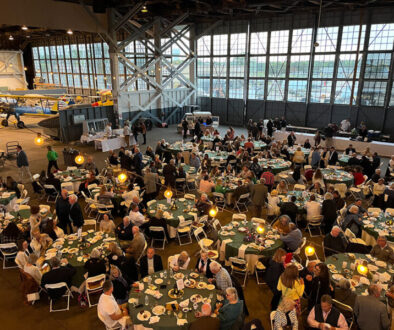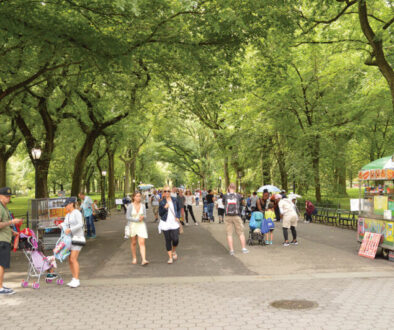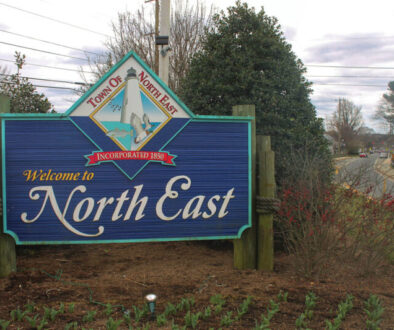Motor + Hotel = Motel
Cape May Accommodations for the Post-War Generation
Postcards fromCAPE PUBLISHING’S ARCHIVES

First there were cars, and then there were people who wanted to get in those cars and drive. Cars allowed people to escape their neighborhoods and towns, to explore places that may not otherwise have been accessible. Cars replaced trains as a preferred way of travel, resulting in a lot of places becoming accessible that could not be reached by train. As people drove, they needed places to eat and sleep—and to park their cars. And so, the first roadside accommodations were created. As car travel gained in popularity, tourist cabins or motor courts were built in the 1930s and 1940s on major roadways throughout the country. These cabins were places where travelers stopped for the night but did not typically stay for extended times. Usually family-run, most had 12 to 14 cabins next to which guests could park their cars while stopping over for the night.
Roads were largely unimproved before World War II, and even afterward, as more and more car travelers took to the roads. In Cape May County, most were narrow two-lane roads built in the early 1800’s to connect major county settlements. Even after the War, it was not unusual to find smaller un-paved secondary roads or wooden bridges connecting the barrier islands with each other or the Cape May County mainland. The Federal-Aid Highway Act, signed by President Dwight Eisenhower in 1956 changed local and interstate travel forever by creating a national system of highways. Small towns had been connected by major roads, but interstate highways bypassed the traffic and congestion of the small towns so that drivers might travel from place to place quickly and efficiently.
And so began the replacement of the tourist cabins in small towns and open country with initially small, but later more elaborate, motor hotels built closer to interstate exits and designed for the car-traveler consumer base.

The closest thing to an interstate highway for New Jersey was the Garden State Parkway, that took years of lobbying and political pressure before the Parkway was extended in 1967 to the now-famous Exit 0. Cape May politicians knew that accessibility by car was an essential economic backbone for the Cape May County coastal communities that depended on visitors for their increasingly growing tourist-based economy. Times had changed. Visitors no longer came by train, and they did not want to spend a whole day driving to Cape May shore communities. They wanted easy-to-get-to places and to have their cars accessible to them while vacationing. Large hotels no longer fit the bill due to their formality, meal plans, and lack of convenient parking. And, then there were fewer and fewer summer cottagers—visitors who spent the summers in homes they owned but only opened for the summer months. Many summer tourists no longer spent the season at the shore but visited for only a week or two. All along the shore, new motor hotels fit the bill for the visitors of the 50s, 60s, and beyond.
In Cape May County, the Wildwoods became the epicenter of new construction. Mom-and-pop operated motels proliferated primarily in Wildwood Crest but extended all the way to North Wildwood. More than 300 motels, built primarily in the 1950s and early 1960s, were designed in what today would be labeled as mid-century modern style. Characterized by “exotic” names, motels like the Caribbean, Royal Hawaiian, or Singapore were decorated in themes matching their names and designed to evoke more exciting destinations than the Wildwoods. Where else could you easily drive to Hawaii than in the Wildwoods?

Politicians and residents in Cape May City were drawn to the successes of Wildwood motels. Many townspeople watched as the Wildwoods became a primary tourist destination. Politicians took note as city revenues grew through the taxes these properties generated. Personnel stationed at Army, Navy, and Coast Guard military bases, in Cape May during World War II, helped bolster the town’s economy, but a vacuum was created when they left at the end of the War. At the same time, Cape May began to lose its many-generation Cottager families who not only owned property but also spent summers as Cape May residents. There was limited motivation for private development due to the decreasing population and tourist base. With accommodations found largely in big hotels and rooming houses and no easy driving routes to this furthest southern shore location, only the most stalwart of Cape May fans persisted in making the five-or-more-hour trip from Philadelphia, Baltimore, or points north. Without tourists, there was limited need for new development projects.
As early at the 1950s, Cape May residents faced an outdated town of poorly kept properties, some abandoned, and some falling down. Townspeople began talking about how to reenergize their town. Some favored demolitions and replacing the old properties with newer modern buildings that would appeal to the post-war generation. Others, led by Dr. Irving Tenenbaum, advocated keeping the older structures but restoring them to build a future economy based not just on summer tourists but on history and architecture.

After more than a decade of battles throughout the 1960s and 1970s, both the modernization and the history and architecture themes were retained, although not always in the exact ways that each of the two groups envisioned. In a nutshell: nobody got everything, but almost everybody got something.
During those two decades, Cape May received a lot of publicity in local and national newspapers and publications. Comparisons with Wildwood were not unusual. Comments that Cape May had escaped the Wildwood “look” or had not successfully created an equal tax revenue base were frequently reported. In actuality, a lot of new motels opened, although Cape May did not come close to the 300 new motels built in the Wildwoods, nor were Cape May motels built around a theme destination. City business owners wanted to provide the type of accommodations that current visitors seemed to want. Owners of the larger hotels worried that this car-traveling generation would go elsewhere and choose more modern places to stay. While some motels were built by out-of-town investors, most were owned and operated by single families, many of whom were long-standing Cape May residents.
The single factor influencing the number of new motels opened during this time was availability of land. The city’s central area was densely built. There were few vacant lots, and those available were too small to support motel construction.

A majority of the existing open land, especially on the beachfront, was east of the city, created when dredging from the Cape May Harbor and Canal was used to fill in nearby wetlands in the blocks east of Madison Avenue. Originally part of the turn-of-the-century failed East Cape May project, land on the four beachfront blocks between Madison and Pittsburgh Avenues remained largely empty. A smaller amount of available beachfront land remained, also, west of the central city area, from Grant Street over to Third Avenue. Once used by the West Jersey Railroad as a station during the summer months, the Summer Station, on the beachfront at Grant Street, and its tracks, removed long before 1950, resulted in a big parcel of beachfront land. As with the eastern side of town, land west of the Grant Street Summer Station was part of several failed development projects. The beachfront and area west of Grant Street originally extended all the way to Cape May Point and included a community called South Cape May which all but disappeared as erosion claimed the land with each succeeding storm. Eventually, only three streets remained to the west of Broadway Avenue.
“While many motels along the beachfront have undergone considerable changes in their size . . . remarkably all still exist and are in business 50-plus years after they were built.”
By the mid-1950s, even though Cape May had fallen onto hard times, a few motels began springing up on these vacant land parcels. On the western side of town, the Bethel family opened the Cape Motel in 1954 on the beachfront between Grant and Windsor Streets, land on which Richard Woods and Henry Lea had built their summer homes a century earlier but which became available when the houses were demolished. This motel, owned and operated by Mr. and Mrs. Howard Bethel, grew through several additions and reconfigurations until this one-story row of a few rooms became a three-story property owned in the 1980s by Ruth and Bob Escher and renamed as the Sandpiper Inn. In 2005, Cape Resorts acquired the property and sold the refurbished units to individual owners. Today the property is a condotel, the Sandpiper Beach Club, owned by many owners but managed by Cape Resorts.

The Surf Motel, built in 1954 at Beach and First Avenue, was designed in a traditional two-story L-shaped configuration with a balcony running along the entire second story, and car parking around the perimeter. This design was a prototype for the many other smaller motels that would be constructed along the Cape May beachfront. By the 1970s, the western beachfront included six motels between the Jetty Motel at the furthest western end of the beachfront and the then-named Cape Motel (Sandpiper Inn) at Grant Street and Windsor Avenue. Motels such as the Mount Vernon, Colton Court, and Surf generally included 30 or fewer rooms.
In 1966, at Patterson Avenue, Julius Hober built the larger 66-room Coachman Motor Inn, and in 1976 opened the Rusty Nail Bar and Grill, a longtime favorite of Cape May locals. This property became timeshares and was sold to Cape Resorts after Mr. Hober’s death in 2005 and is now operated as the Beach Shack.

One of the first motels built on the eastern beachfront was the 36-room Beach Tower Motel at Pittsburgh and Beach Avenues, several blocks to the east of the center of town. On the 50th year of the family’s ownership, Gus Andy, who came to Cape May from Greece, described the motel he purchased in 1969 as “rundown, with shag carpets, and damp odors—a diamond in the rough.” Over the next 50 years, the Beach Tower grew from a small motel into the multi-storied 162 room La Mer Beach Resort.
The Grand Hotel started life in 1964 as the 52-unit Golden Eagle. Designed by Cape May County architect James M. Clark, Jr, and constructed by Thomas Lepore & Son at Philadelphia Avenue, it was the first motel to have an Olympic-size swimming pool. Two years later, in 1966, just down the beachfront at Madison Avenue, Sophie and Harry Hirsch, who came to Cape May from Poland, purchased land, and built the 27-room Montreal Inn. Harry hoped the name would attract Canadian visitors who were vacationing in Cape May—and it did. A year later they expanded the motel to 31 rooms and added a restaurant, cocktail lounge, and coffee shop. Over the next 50 years, like the Andys, the Hirsh family continued to expand the motel, transforming it into the Montreal Beach Resort.

The new motels along the eastern beachfront blocks extended from the La Mer on the far eastern Pittsburgh Avenue block to just past the Hunt’s Beach Theatre to Stockton Place, where the Heritage Motel was built. Of the 12 motels built on these blocks, most started out with 24 to 30 rooms designed in the two-story L configuration.
But there were exceptions. The Atlas Motor Inn, built in 1971, east of Madison Street and rebranded with new owners in 2011 as the Ocean Club Resort was six-stories tall. Next door is the Periwinkle Inn, with its unusual design where two parallel rows of rooms are positioned perpendicular to the beachfront. The four-story Camelot Motel was built about a half-block back from the beachfront at Howard Street on land that became available after a fire destroyed the Green Mill, a pre-World War I amusement center, in 1966.

While many motels along the beachfront have undergone considerable changes in their size, physical structure, amenities, and marketing, and while some have been re-configured from rooms into suites, or added bars and restaurants, or converted into condotels or condominiums, remarkably all still exist and are in business 50-plus years after they were built.
Advertisements document the ways in which amenities changed over the years. Motel advertisements in the 1960s rarely mentioned air-conditioning, but by the 1970s and 1980s, all motels listed air-conditioning as an amenity. Similarly, the earliest built motels did not offer television although many noted the availability of radio; later, many advertised not only television but color television. Few early motels had swimming pools, but these quickly became available, easily installed in the area created by the L-shape design.

Cape May beachfront motels were located away from the center of town or Convention Hall where most of the entertainment for summer visitors took place. Both the lack of available land and demand for motel accommodations resulted in additional motels built further away from the beach. Several were built on Pittsburgh Avenue, favorites of the nearby Coast Guard community. The Planter Motel, later named the Cape Winds, was built in the 1970s on Lafayette Street where the demolished Hotel Dale, an African American-owned establishment, was originally located. Operated by John Nash to continue the tradition of serving African-American tourists, today the motel has been refurbished and operates as Boarding House. Further into the center of town, with its dense buildings and limited open land, longstanding owners of the Colonial (now the Inn of Cape May), Lafayette, Baltimore, and Colton Court Hotels were concerned that they would lose business to these new motels and wanted to be able to offer equal accommodations. City politicians and business leaders also wanted motels closer to Cape May’s business blocks with their stores and restaurants. An issue became how to get the land to make new in-town motels without demolishing historic structures which was not permissible under the City’s 1960s urban renewal project.
Bob Fite, then owner of the Colonial Hotel, obtained the Stockton Bath Houses land next to the hotel and then sold the two Star Villa properties across Ocean Street from the Hotel for $1.00. Lafayette Hotel owner Henry Needles sold the Weightman Cottages, next to the Star Villa, on the corner of Ocean Street and the beach, thus creating the land needed for both the Colonial and the Lafayette to build the motels they desired next to their properties. Both owners felt that their future profitability depended on a pool, air conditioning, parking, and the more modern facilities demanded by post-war tourists.

The 50-unit Colonial Motel, with its pool and cocktail lounge, opened for the 1966 summer season but eventually was sold off and now is operated as the Avondale Motel. The Star and Wave noted in 1964 that “the Lafayette Motel was well underway” being constructed adjacent to the historic Lafayette Hotel. Early drawings show an exceptionally modern addition to the historic hotel, but the Lafayette Hotel was then torn down as part of urban renewal in 1970 and replaced with the modern hotel and parking lot that remains today.
Cape May was marketing itself on preservation and Victorian architecture, but this theme competed with one of a new and modern town and was insufficient in stopping demolition of Victorian properties. During the late 1960s, properties within the urban renewal Victorian Village zone were demolished to create space in town for motel accommodations. On Jackson Street, the Baltimore Inn was razed to make way for an unsuccessful new motel that eventually became the Tides Condominiums.

The Elberon Hotel on Congress Place along with several other demolished structures created land for the modern Victorian Motel, which still exists at the end of the Mall along Perry Street. The now-famous Pink House, next to the Elberon Hotel, was saved only after Tom Hand purchased and moved it across the street next to the Star and Wave offices. Along the beachfront, at Patterson Street, the Colton Court Hotel was demolished and replaced by the Colton Court Motel. These new structures not only offered modern accommodations but even more importantly, they offered parking.
The history and architecture theme that supported urban renewal and the Cape May revival saved the town from wholesale demolition and new construction and resulted in a balance between retention of the old and creation of the new. As the 21st century began, more than half of the 300 motels built in the Wildwoods in the 1960s had been demolished and replaced with more popular condominiums. Mom and pop operators, now of retirement age, sold out to developers. In contrast, while in the past 20 years, many properties in Cape May have been demolished, more often than not, those modern new motels of the 1960s still stand, some operated over the past 50-plus years by the same families, and many updated over the years to continue to appeal to today’s tourists. ■




